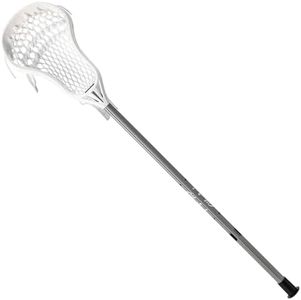We Use CookiesWe use cookies to enhance the security, performance,
functionality and for analytical and promotional activities. By continuing to browse this site you
are agreeing to our privacy policy
4 Best Lacrosse Sticks
From leading brands and best sellers available on the web.Buying Guide for the Best Lacrosse Sticks
When choosing a lacrosse stick, it's important to think about your playing style, experience level, and position on the field. The stick is made up of two main parts: the shaft (handle) and the head. Every aspect, from the material and length to the type of pocket, can affect your performance and comfort. Whether you are new to lacrosse or have been playing for a while, making an informed choice helps you play your best and enjoy the game.Stick LengthStick length is the total measurement of the shaft plus the head and it is mainly determined by your position on the team—attack/midfield sticks are shorter, defense sticks are much longer, and goalie sticks are unique. Shorter sticks (typically around 40-42 inches) are lighter and allow quicker hand movements for attackers and midfielders. Defensive sticks (usually 52-72 inches) provide extra reach for blocking and checking. Goalies use sticks that are generally in the 40-72 inch range but have large heads for easier saves. To pick the right length, match it to your position and height, as having a stick that feels manageable helps boost skill development and comfort.
Shaft MaterialThe shaft, or handle, is mostly made from materials like aluminum, composite (carbon fiber), or alloys. Aluminum is lightweight and a good starter choice, while composite shafts are more advanced, offering strength and flexibility with less weight. Alloy shafts blend lightness and durability. Beginners might prefer lighter, less expensive materials since they're easy to control, but advancing players may appreciate the feel and balance of a sturdy composite or alloy. Your position and how physical your play is should also help guide your choice.
Head Shape and StiffnessThe head is the top part of the stick where the pocket holds the ball. Heads come in different shapes—wider heads are easier for learning ball-handling and catching, while narrower heads offer more precision and control for advanced play. Stiffness is another factor: stiff heads are durable and good for defensive players, while flexible heads give a better touch for attackers. Decide based on your skill level and what you need most—ease of use for beginners or sharper accuracy and control for more experienced players.
Pocket TypeThe pocket is the mesh or strings forming the part of the head that holds the ball. Traditional stringing uses leather and is less common today, but mesh is widely used for its consistency and ease of maintenance. The pocket depth matters—deeper pockets provide more ball control and protection (good for defenders), while shallower ones allow quicker releases (great for attackers). Choose the pocket style and depth based on your position and what feels right for your level of stick handling.
Grip and ShapeThe grip and shape of the shaft affect how the stick feels in your hands. Some shafts are completely smooth while others have textured grips, and some are straight while others are slightly octagonal or have ergonomic features. If you play in wet or muddy conditions, a better grip can prevent slips. Choose a grip and shape that feels comfortable and secure when you practice basic movements, as that ensures good control during gameplay.
WeightThe overall weight of the lacrosse stick will impact how fast and agile you are with handling the ball. Lighter sticks offer quicker reactions and easier maneuverability, ideal for attacking players, whereas heavier sticks offer more power and are often preferred by defenders who need stronger checks. Assess your own physical strength and playing style—pick a stick weight that you can manage easily for long periods on the field.





